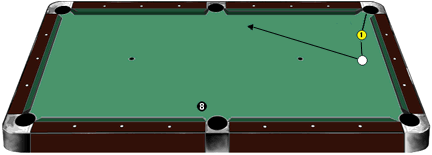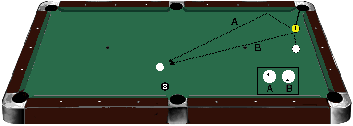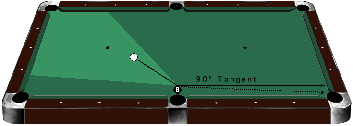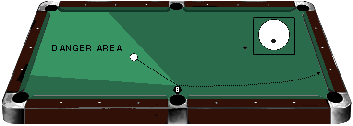
When the cue ball contacts an object ball with no top, bottom or side spin, it will deflect off the object ball at a 90 degree angle to the object ball's path to the pocket. For example:
Figure A

You want position on the 8-ball after a shot to pocket the 1-ball. By following the natural tangent, you might get the position you want, but there is a chance of scratching in the side pocket. Or, maybe there is an interfering ball along the tangent line.
Figure B

By using top or bottom you can bend the tangent line for better position, or to avoid an interfering ball. In the event there is an interfering ball along the altered tangent line, you have the option of reaching the same position point with different tangent paths. Path "A" is off the rail, while path "B" is bent back down and across the table. See "hits" A & B on the cue ball. A little outside spin is used in both instances
Figure C

If the cue ball is anywhere within the shaded area, a shot at the 8 ball in the side can result in a common scratch. Although the natural tangent line is to the short rail clear of the corner pocket, many beginners end up scratching in the corner (broken line). This is because the cue ball can pick up top spin due to friction with the cloth. Top spin will cause the cue ball to bend off the tangent and toward the corner pocket. Remember, to follow a natural tangent line there can be no roll or spin on the cue ball when it contacts the object ball.
Figure D

Protect yourself against the scratch in this situation by placing a little bottom on the cue ball. When the cue hits the object ball it will bend the tangent line back away from the corner. IMPORTANT: Do not shoot easy! If you shoot timidly, the cloth will rub the bottom spin off the cue ball causing it to start rolling forward. The cut is too thin to shoot easy and expect the cue ball to consistently stop short of the corner.
POSITION:
If you are not shooting at the money ball, and need to get position on another ball after sinking object ball in the side, placing extreme bottom on the cue from where it sits in Figure D can get you just about anywhere on the table, especially if you cheat the pocket. Practice this shot a lot and learn what is possible.
(Figure D) Using bottom english to bend back from a scratch in the corner can backfire if your hit the object ball too thin. Hitting the shot thin creates a tangent line to the long rail between the side and corner pockets, and bottom english can actually bend the tangent to, and not away from the corner. Also remember that bottom and top english affect the tangent line proportionately less with increasingly thinner cuts on the object ball. Thicker hits on the object ball slows the cue down and allows spin to react with the cloth sooner for more dramatic bending off the tangent line.